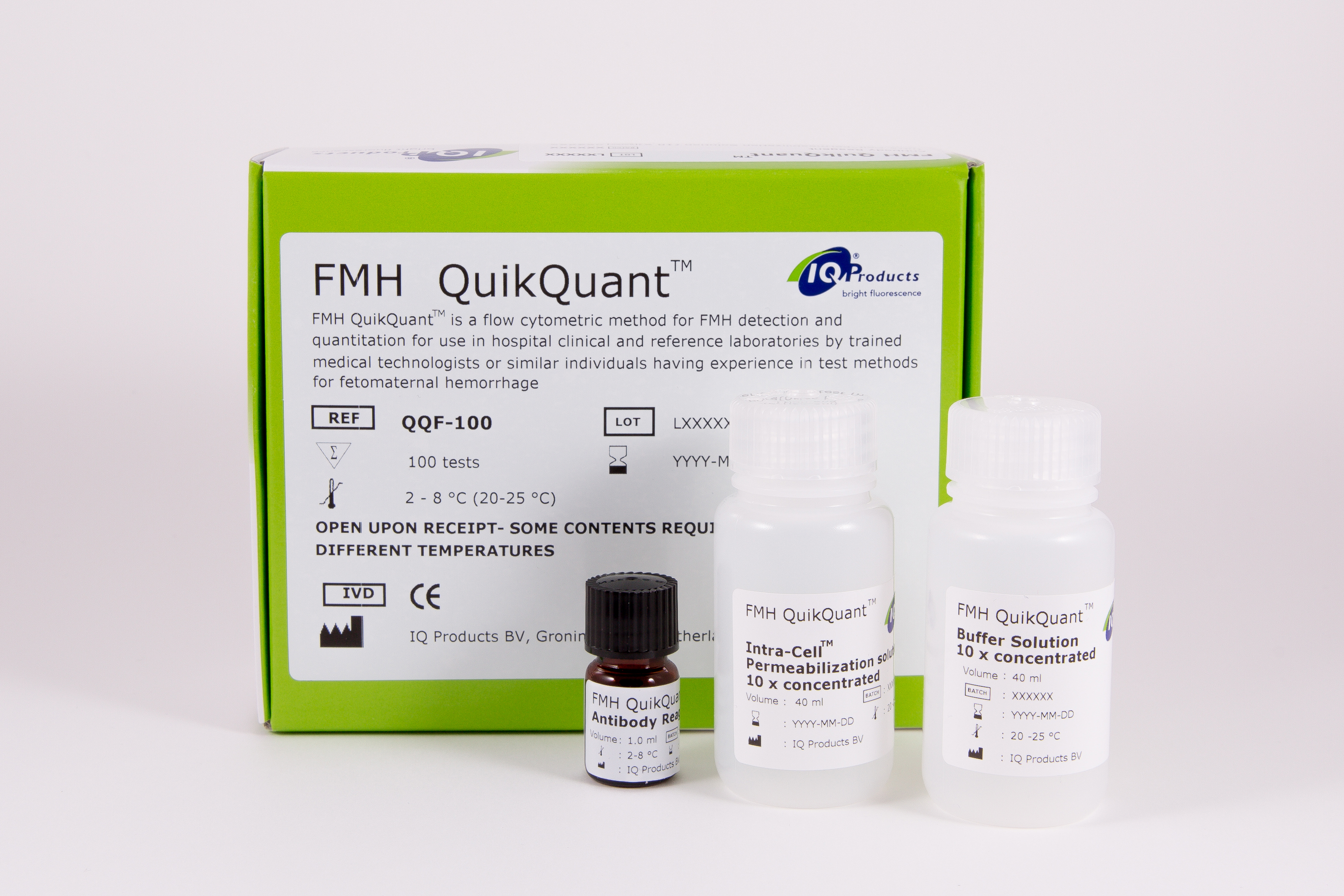FMH QuikQuant ™ is a flow cytometric method for FMH detection and quantitation. The assay uses a reagent containing a monoclonal antibody to Hemoglobin F and Propidium Iodide as a specific marker of nucleated cells. The method is a rapid streamlined technique requiring about 30 minutes to complete. With less than 15 minutes of technologist time needed, it is more efficient to use than the KB assay, as well as more sensitive and precise.
Key benefits
- New technique is quicker to perform
- PI provides a definite tool for gating out the WBCs
- Kit includes 10X concentrated permeabilization reagent
- Works well with FETALtrol as a system control
Features
- Detection of fetal hemoglobin (HbF) of as low as 0,06% fetal cells in maternal blood
- Results in 1 hour (20 minutes hands-on-time) with two single centrifuge steps
- Registered as Medical Device for In Vitro Diagnostic Use (IVD/CE)
Applications
- Determination of Fetomaternal Hemorrhage
- Pregnancy with suspected RhD incompatibilities
- Abdominal trauma
Introduction
The most important clinical use of fetal RBC detection is the diagnosis and quantitation of fetomaternal hemorrhage (FMH). FMH occurs normally throughout pregnancy in minute amounts, with increasing volumes during the later stages of gestation. If there is a significant difference in the RBC antigenicity between the fetus and mother, this can result in allosensitization of the maternal immune system either before or after parturition. The maternal antibodies to the fetal RBC antigens may be clinically silent or cause life-threatening autoimmune sequelae for the current or subsequent pregnancies (e.g.: erythroblastosis fetalis or early abortion). Such sensitization can occur with any RBC antigen mismatch, but the highest frequency and profound clinical consequences occur with Rh or D-antigen mismatches.
Detection and enumeration of Fetal RBCs is an essential part of the management of those patients with FMH treated with Rh immune globulin (RhIG) preparations. The use of Rh immune globulin prophylaxis is a universal practice, but dosing amounts and schedules have regional variations. Hence, the sensitivity and specificity of detection assays for FMH is a critical factor in therapeutic efficacy and subsequent clinical outcome.
The most widely used assay for FMH detection has been the visual microscopic counting Kleihauer-Betke (KB) method, which is based upon the differences in solubility properties in acid conditions of fetal hemoglobin (HbF) from adult hemoglobin. While the KB method is easily performed by most clinical laboratories, it lacks sensitivity and exhibits poor reproducibility or precision (CVs of 50- 100%). Flow cytometric methods have been developed using the antigenic differences or quantitative assessment of fetal hemoglobin (HbF) to distinguish fetal RBCs from adult RBCs. These methods are more precise and less subjective. Nonetheless, many laboratories have continued to use the KB method due to the limited availability of Flow Cytometry.
Current literature utilizing and supporting FMH QuikQuant™:
1.
Wong L, Hunsberger BC, Bruce Bagwell C, Davis BH.
Int J Lab Hematol. 2013 Oct;35(5):548-54. doi: 10.1111/ijlh.12060. Epub 2013 Mar 22.
PMID: 23521723
2.
Evaluation of FMH QuikQuant for the detection and quantification of fetomaternal hemorrhage.
Pastoret C, Le Priol J, Fest T, Roussel M.
Cytometry B Clin Cytom. 2013 Jan-Feb;84(1):37-43. doi: 10.1002/cyto.b.21052. Epub 2012 Oct 26.
PMID: 23027716 Free Article
3.
Fong EA, Finlayson J, Robins F, Davies J, Joseph J, Rossi E, Grey DE.
Int J Lab Hematol. 2013 Feb;35(1):106-10. doi: 10.1111/j.1751-553X.2012.01463.x. Epub 2012 Aug 14.
PMID: 22889294
4.
de Wit H, Nabbe KC, Kooren JA, Adriaansen HJ, Roelandse-Koop EA, Schuitemaker JH, Hoffmann JJ.
Am J Clin Pathol. 2011 Oct;136(4):631-6. doi: 10.1309/AJCPHL3VXY0VMLXL.
PMID: 21917687 Free Article
Package Insert
Danish: Produktinformation
English: Product information
French: Fiche Technique
German: Produktdatenblatt
Greek: Πληροφορίες για το προϊόν
Italian: Informazioni sul Prodotto
Norwegian: Produktinformasjon
Polish: Informacje o produkcie
Portuguese: Informações sobre o produto
Spanish: Información del producto
Swedish: Bruksanvisning
Turkish: Ürün Bilgileri
Russian: информация о продукте
Question: What is recommended to use as a positive control for HbF if you don’t have cord blood available?
Answer: FETALtrol™ can be used as an external control. This is a quality controlled tri-level stabilized blood control with a known percentage of HbF positive cells in adult blood.
Question: How do you exclude nucleated cells from the analysis?
Answer: While PI is a specific marker for nucleated cells, autofluorescence can be used in setting regions when enumerating F- cells.
